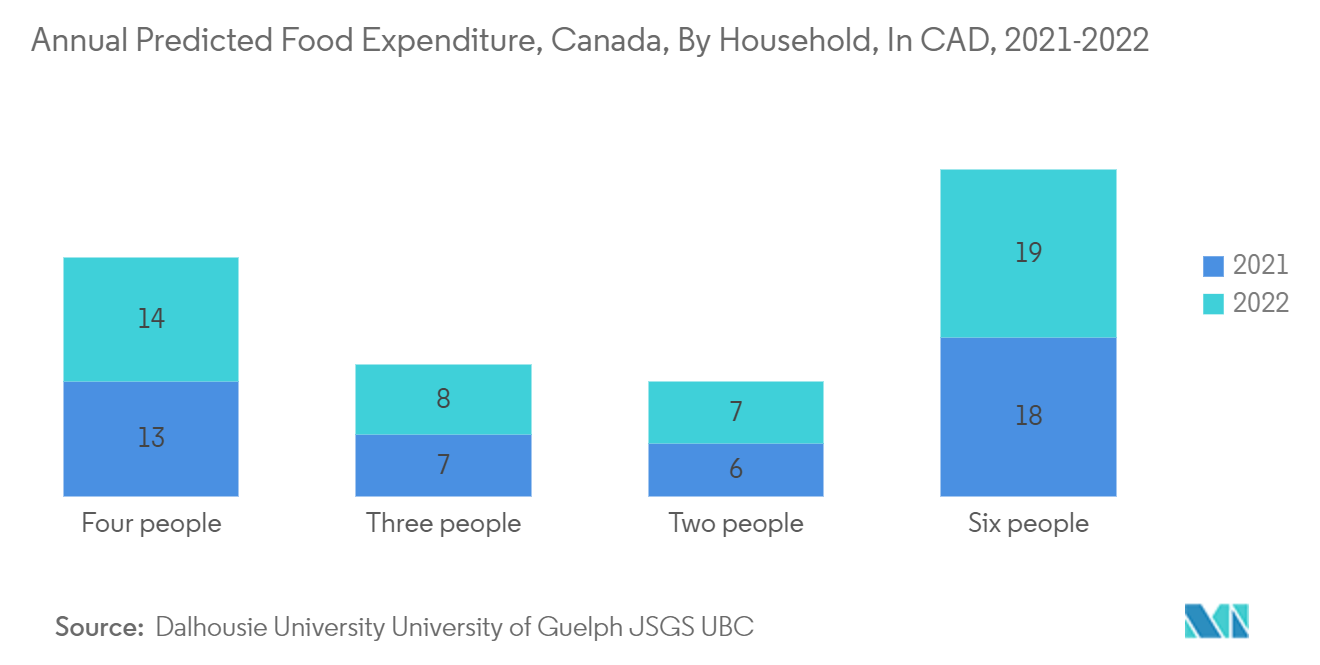Market Trends of Canada Foodservice Packaging Industry
This section covers the major market trends shaping the Canada Foodservice Packaging Market according to our research experts:
Demand for Convenience Food Remains High in Canada
- The food and beverage industry surged during the pandemic as an increasing number of people across the country stocked up their supplies during lockdowns. Due to this, the packaging industry also surged exponentially. In addition, packaging has undergone transformational changes since the inception of flexible packaging. Numerous manufacturers have considered its benefits in production costs, marketing, and product promotion.
- Consumer health consciousness and increased demand for healthy and tasty food are driving the market growth of convenience food. The high female employment rate also positively impacts the market; growth in several fast-food restaurants, which results in easy access to fast food and tech-savvy ordering, fueling the development of the Canadian fast-food industry, has increased demand for food service packaging solutions. Furthermore, increased exposure to international cuisine through media and travel will fuel the growth of this market.
- Many companies focus on product innovations to hold a significant position in the market studied. For instance, in November 2021, Tupperware designed a custom-made reusable packaging container for Tim Hortons. The container was scheduled to be trailed in five Tim Hortons locations in Burlington, Canada. The goal is to create a simple system for restaurants and guests, letting them enjoy reusables while maintaining single-use convenience. The containers were Tupperware's first collaboration with TerraCycle's Loop reuse platform.
- Fast food is extensively used in end-user industries like Quick Service Restaurants (QSR), Street Vendors, Home Delivery, Cafés, bars, etc. Quick-service restaurants are the most favored by Canadian consumers, increasing demand for fresh, tasty, and appealing food at affordable cost. Thus, the need for packaging in Canadian foodservice is rising.

Quick-service Restaurants (QSR) Expected to Grow in Future
- Despite the fast-paced at-home lifestyle era, QSRs have managed to satisfy a fundamental need in today's social climate. The ability to order hot-and-ready meals online has become a critical pillar for QSRs. Canadians frequently prefer quick-service restaurants as an easy and delicious alternative to cooking meals at home while juggling COVID-19 restrictions and their busy lifestyles.
- The Canadian food industry has changed and evolved to meet customer needs and consumer behavior. As a result, fast food has seen its roots in developing economies over time, primarily due to its quick availability and taste. Food service packaging is gaining popularity as more consumers choose takeout and delivery while operators continue to prioritize food safety and efficiency behind the scenes.
- According to data from Restaurants Canada, the Canadian commercial food service industry will grow significantly throughout 2022, outpacing its nominal 2020 decline by USD74.6 billion, a 22% increase over 2021. Quick-service restaurants will be worth USD 37.4 billion in Canada alone by 2025.
- The recent data published by StatCan in October 2022 showed that Canada's food services and drinking places are heavily impacted by COVID-19. However, in 2021 sales began to reflect pre-pandemic levels again. in July 2021, sales of Canadian Dollars were recorded at 6.7 billion. Additionally, in August 2022, the sales of the month of food services and drinking places in Canada amounted to 7.85 Billion.
- For instance, in October 2021, McDonald's Canada stated that it would be getting rid of plastic cutlery, stir sticks, and straws by December 2021. The phase-out has occurred at more than 1,400 Canadian locations and comes as the government of Canada moves to ban single-use plastics, with regulations finalized by the end of 2021. Wooden cutlery and stir sticks were already being rolled out in restaurants, with paper straws from November 2021. McDonald's aims to use 100% recycled, renewable or reusable materials in all its customer packaging in all of its restaurants by 2025.


